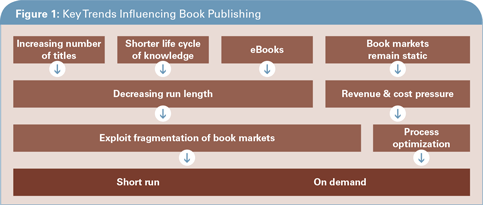Integrating Book Manufacturing for Run Lengths of One
For publishers, digital printing technology is an industry-transforming initiative. Instead of printing more books than they sell, publishers can order smaller quantities, minimizing risk by reducing inventory and distribution costs. Savvy managers know that it’s the total cost divided over a title’s life cycle that counts – not just the initial cost of printing the book. With digital technology, publishers can adapt to fluctuations in demand over a title’s entire life cycle.
In addition to reducing up-front cash outlays and costs over the life of a title, digital book printing improves life cycle margins and gives publishers more flexibility in what is printed. By eliminating the dilemma of the minimum print run, publishers can bring a wider selection of quality offerings to the market. At the same time, they can access the value of their backlists and associated revenue streams. With tighter control of quantities, more titles stay active longer. This means that costly reprints are replaced with a “never-goes-out-of-print” solution.
Multiple Options for Driving Profitability
Just as book publishers must evolve the publishing model to improve earnings and reduce risk, book printers must adopt better ways to achieve and sustain profitability and respond to orders for long and short runs. Replacing traditional long-run manufacturing techniques with efficient, short-run digital production aligns supply more closely with demand. This enables book printers to acquire new customers and build market share by offering more services. It also strengthens relationships with book publishers, enabling them to keep titles in print longer and cut their losses on poor sellers.

The Integration Challenge
The biggest challenge for generating a “Books on Demand” system is integrating all components from order entry to fulfillment. Integration generally means combining parts so that they work together to form a whole. “On Demand Book Production” requires tools to combine components and subsystems. The goal is to create a fully integrated book factory that inputs plain paper at one end and outputs fully finished books at the other. That’s where Canon Solutions America and its Océ PRISMA® workflow software comes in!
Adaptive Workflows Enhance Efficiency
Océ PRISMA workflow software can be customized and individually tailored to match each book printer’s unique requirements. With Océ PRISMA adaptive workflow software, you can receive and accept jobs over the Web, intranet, network, or via CDs. You can scan hard copy originals, eliminate hard copy proofs, guarantee front-to-back registration, combine and edit multiple PDF files, impose pages on the fly, and accept print files from non-Océ workflows.
Canon Solutions America has also created a “Book of One” Océ PRISMA software extension to facilitate the efficient production of books in a run length of one. Large manufacturers have developed software tools that appropriately gang books to automate production and finishing. Unfortunately, smaller book printing companies didn’t have the resources to create this complex IT infrastructure. They were forced to enforce a minimum order quantity based on imposition requirements or produce what the publisher requested, possibly generating waste. Canon Solutions America’s “Book of One” solution automates book production through a highly efficient batch, barcode, and scanning process. This software groups jobs based on parameters that improve process efficiency. This includes trim size, media, imposition, finishing (perfect or saddle stitched), and most importantly page count. Every five seconds, orders in each queue are read and sorted by page count. If the copy count allows for multiple impositions, the software immediately breaks a job into appropriate quantities to optimize production capabilities. This automation helps reduce production costs while maximizing revenue. With automated “Book of One” production, print providers of all sizes and capabilities are better prepared to compete in the digital book printing arena.
Finally, no two book manufacturing facilities are the same. If a customer doesn’t have the resources to create its own streamlined workflow, Canon Solutions America has a team of professional services specialists that can support the integration process. Support includes integration of the installed solution components, connecting hardware and software to your network up to full integration into your environment, and migration services to simplify the implementation process.
The Bottom Line
You need a combination of the right tools and partners to create a seamless, efficient, automated book factory that delivers results for your business as well as the publishers you serve. No one can go it alone given the complexities of today’s market. In addition to offering comprehensive software tools, Canon Solutions America provides professional services for efficiently generating “Books on Demand.”
